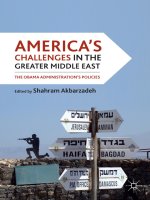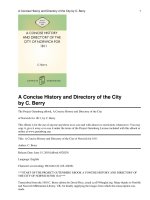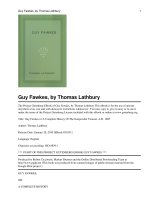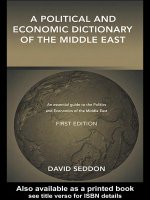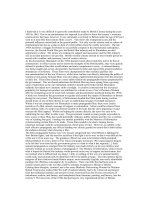the modern middle east a political history since the first world war
Bạn đang xem bản rút gọn của tài liệu. Xem và tải ngay bản đầy đủ của tài liệu tại đây (5.29 MB, 514 trang )
TeAM
YYeP
G
Digitally signed by
TeAM YYePG
DN: cn=TeAM YYePG,
c=US, o=TeAM YYePG,
ou=TeAM YYePG,
email=
Reason: I attest to the
accuracy and integrity of
this document
Date: 2005.05.15
04:31:35 +08'00'
THE MODERN MIDDLE EASTThe Modern Middle East
A Political History since the First World War
MEHRAN KAMRAVA
UNIVERSITY OF CALIFORNIA PRESS
Berkeley Los Angeles London
University of California Press
Berkeley and Los Angeles, California
University of California Press, Ltd.
London, England
© 2005 by the Regents of the University of California
Library of Congress Cataloging-in-Publication Data
Kamrava, Mehran, 1964–.
The modern Middle East : a political history since the First World
War / Mehran Kamrava.
p. cm.
Includes bibliographical references and index.
ISBN 0–520-24149-5 (alk. paper).—ISBN 0–520-24150-9 (pbk. :
alk. paper)
1. Middle East—History—20th century. I. Title.
DS62.8.K365 2005
956.04—dc22 2004008821
Manufactured in the United States of America
13 12 11 10 09 08 07 06 05
10987654321
The paper used in this publication meets the minimum requirements of
ANSI/NISO Z39.48–1992 (R 1997) (Permanence of Paper). ϱ
To Melisa and Dilara
List of Tables xi
Acknowledgments xiii
Introduction 1
PART I. A POLITICAL HISTORY OF THE MIDDLE EAST 7
1. From Islam to the Great War 9
2. From Territories to Independent States 35
3. The Age of Nationalism 67
4. The Arab-Israeli Wars 107
5. The Iranian Revolution 138
6. The Gulf Wars and Beyond 169
PART II. ISSUES IN MIDDLE EASTERN POLITICS 213
7. The Palestinian-Israeli Conflict 215
8. The Challenge of Economic Development 257
9. States and Their Opponents 283
10. The Question of Democracy 331
11. Challenges Facing the Middle East 359
Notes 377
Bibliography 429
Index 457
Contents
FIGURES
1. Turkish women in a late nineteenth-century harem 25
2. Women in Algiers in the 1880s 48
3. Mustafa Kemal Atatürk and Reza Shah Pahlavi confer 59
4. Female members of the Iraqi Home Guard march
in Baghdad, 1959 71
5. David Ben-Gurion, the first prime minister of the state of Israel 77
6. Tel Aviv, 1948, Israeli women take an oath to join the Haganah 78
7. Egyptian women celebrate Nasser’s announcement
of women’s right to vote, 1956 93
8. Egyptian boys and girls receive military training during the
Suez Canal crisis, 1956 95
9. Israeli soldiers celebrate capturing Jerusalem in the 1967 War 120
10. Egyptian soldiers celebrate crossing the Suez Canal
in the 1973 War 130
11. Ayatollah Khomeini, leader of Iran’s Islamic revolution 153
12. Ten years after Khomeini’s death, his legacy remains strong in Iran 165
13. President Saddam Hussein 175
14. Female Iraqi soldiers express support for the occupation of Kuwait 184
15. Iraqi forces on the “highway of death” 190
16. Shi‘ite Iraqi women mourn after the Gulf War in 1991 192
17. Osama bin Laden’s videotaped messages were broadcast
on Al-Jazeera 203
18. Taliban rule brought ruin to Afghan lives and cities 204
19. U.S. forces invade Iraq to overthrow Saddam Hussein’s regime 206
20. Saddam Hussein’s statue is toppled in Baghdad 209
21. British occupation forces search Iraqi women for weapons 210
22. Yasser Arafat, chairman of the PLO and president of the PNA 228
23. Palestinian women argue with an Israeli soldier
during the first intifada 229
24. Yitzhak Rabin and Yasser Arafat sign the Oslo Accords 244
25. Prime Minister Ariel Sharon, with a photo of Theodor Herzl
in the background 250
26. Women march in support of Hamas 252
MAPS
1. The modern Middle East xiv
2. The Sykes-Picot Agreement 41
3. French and British Mandates after World War I 44
4. The United Nations Partition Plan 80
5. Territories captured by Israel in 1967 119
xi
Tables
1. Jewish Immigration in Each Aliya 76
2. Phases in Palestinian Nationalism 85
3. Palestinian Refugees of the 1948 War 88
4. Troop and Tank Strength in the Second Gulf War (January 1991) 187
5. Palestinian Population by Place of Residence 225
6. Post-1967 Settlements in the Occupied Territories 236
7. GNP Growth Rate in Selected Developing Countries, 1970–95 262
8. Growth of GDP in Selected Middle Eastern Countries, 1980–2001 263
9. Ideal State Types in the Middle East 284
10. Population Characteristics in the Middle East 361
11. Fertility Rates in the Middle East 362
12. Determinants of Fertility in Islamic Countries 363
13. Foreign Labor Force in the Oil Monarchies 364
14. Citizen and Noncitizen Population in the Oil Monarchies 365
15. Age Structure in the Middle East, 2002 366
16. Per Capita Water Availability and the Ratio of
Supply and Demand in the Middle East 370
out the kindness and generosity of a number of individuals. I greatly ben-
efited from the research assistance of Annmarie Hunter and Emily
Smurthwaite. I am most grateful for their diligence and their enthusiasm
for this project from start to finish. Terrence Thorpe, another outstanding
student, also read several chapters and gave valuable suggestions. Bradford
Dillman, Manochehr Dorraj, Nader Entessar, Mark Gasiorowski, Nikki
Keddie, and Mahmood Monshipouri kindly read all or some of the chapters
and gave invaluable and insightful advice. Of course, any omissions or
shortcomings remain entirely my fault. Work on Chapter 8 was partly
funded by a generous grant from the College of Social and Behavioral Sci-
ences at California State University, Northridge.
This book is the outgrowth of more than a decade of teaching and lec-
turing on the politics and history of the Middle East. In the process, I have
learned a great deal from the innumerable students who have shared with
me their insights, experiences, criticisms, and comments. Both directly and
indirectly, their input is no doubt reflected here. For that, I am grateful.
Chapter 9 is an expanded, much revised version of an article that origi-
nally appeared in Third World Quarterly, Vol. 19, No. 1, 1998, pp. 63–85.
I am grateful to TWQ’s editor, Shahid Qadir, for permission to quote
extensively from the article here.
My wife, Melisa Çanli, deserves special thanks. Over the nearly five
years that it took to write this book, she put up with my many solitary
hours behind the computer, my frequent mood swings, and my far-too-
often frowns. All along, she never wavered in her loving support for my
work. As I was in the final stages of preparing the book, she gave birth to
our beautiful daughter, Dilara.As a meager token of my love and gratitude,
I dedicate this book to them both.
Acknowledgments
Map 1.
The modern Middle East.
ISRAEL
LEBANON
BAHRAIN
QATAR
UAE
MAURITANIA
MOROCCO
ALGERIA
TUNISIA
LIBYA
EGYPT
SUDAN
JORDAN
SYRIA
TURKEY
IRAQ
IRAN
SAUDI
ARABIA
OMAN
YEMEN
0 200 400 600 800 miles
KUWAIT
Introduction
This book examines the political history of the contemporary Middle East.
Although it focuses primarily on the period since the demise of the
Ottoman Empire, shortly after World War I, it includes some discussion of
pre-Ottoman and Ottoman histories to better clarify the background and
the context in which modern Middle Eastern political history has taken
shape. The book uses a broad conception of the “Middle East” as a geo-
graphic area that extends from Iran in the east to Turkey, Iraq, the Arabian
peninsula, the Levant (Lebanon and Syria), and North Africa, including the
Maghreb, in the west. Maghreb is the Arabic word for “occident” and has
historically been used to describe areas west of Egypt. In modern times, it
has come to refer to Tunisia,Algeria, and Morocco. Libya is also sometimes
included as part of the Maghreb, but it is more commonly grouped with
Egypt as belonging to North Africa.
Although there are vast differences between and within the histories,
cultures, traditions, and politics of each of these regions within the Middle
East, equally important and compelling shared characteristics unify the
region. By far the most important of these are language, ethnicity,and reli-
gion. Much of Middle Eastern identity is wrapped around the Arabic lan-
guage. Poetry and storytelling have historically been viewed as elevated art
forms. As the gifted Fouad Ajami has observed, “[P]oetry, it has been said,
was (and is) to the Arabs what philosophy was to the Greeks, law to the
Romans, and art to the Persians: the repository and purest expression of
their distinctive spirit.”
1
Even in places where it is not the national language
and is not widely spoken, as in Iran and in Turkey, Arabic, the language of
the Quran, permeates life with its many expressions and phrases.
Another common bond in the Middle East is Arab ethnic identity. From
Iraq in the north down to the Arabian peninsula and west all the way to
1
Morocco, ethnic Arabs predominate. There are, of course, significant clus-
ters of other ethnic groups. A majority of Iranians are Persians, and Turks
are predominant in Turkey. Apart from the so-called “Arab-Israelis”—
Palestinians who found themselves in Israel’s borders when the country
was born in 1948—Jews are the dominant group in Israel. As Chapter 7
discusses, however, there is a debate as to whether Jews are members of an
ethnic group or believers in a religious faith. Additionally, there are sev-
eral “stateless” ethnic groups, by far the largest being the Kurds, who are
mostly in southeastern Turkey, western Iran, northern Iraq, and north-
eastern Syria. There are also sizable Berber communities throughout the
Maghreb. But despite these diverse ethnic communities, much of the Arab
world remains ethnically homogenous and strongly identifies with its
ethnicity.
An even stronger bond uniting the region is religion, with some 97 per-
cent of Middle Easterners identifying themselves as Muslim. That Islam is
a whole way of life and not just a religion is a cliché. But regardless of their
ethnicity, where they live, and what language they speak, the faithful share
a compelling set of beliefs and rituals that transcend national boundaries
with remarkable ease.At its strictest, Islam is austere and exacting. But even
in its most liberal settings and interpretations, it permeates the life of the
Middle East in ways few other phenomena do. Its relentless emphasis on
community, its injunctions on the one billion faithful to all face Mecca in
prayer and to fast together in the same month, its deep penetration of lan-
guages far removed from Arabic, its reverence for the Prophet Muhammad,
who called for submission (Islam) to God (Allah)—all of these reinforce
the sense of belonging to a whole far bigger than its individual, national
components. Since the early decades of the twentieth century, Islam
as a source of cross-national unity has steadily lost ground to state-
specific nationalism, but it remains a powerful source of common
identification among fellow Muslims around the world, especially in
the Middle East.
In addition to the important, uniting phenomena of ethnicity, language,
and religion are the curse and the blessings of a common historical her-
itage. Much of the Middle East, with the exceptions of Iran and Morocco,
experienced centuries of Ottoman rule, generally from the mid–sixteenth
century up until the waning years of the nineteenth century. The
Ottomans’ hold on the Middle East was often tenuous and frequently
interrupted. Over the centuries, however, for better or for worse, from
their capital in Istanbul they managed to leave their mark on such far-off
places as Cairo, Tripoli, and Tunis. Once the Ottomans were gone, the
2 / INTRODUCTION
British and the French took their place, leaving on their colonial posses-
sions their own distinctive marks. Perhaps the biggest relic of British rule,
aside from the drawing of artificial national borders, was the institution of
monarchy, which they secured in almost all the lands they ruled, from
Egypt to Jordan, Iraq, and the Arabian peninsula. The French colonial
inheritance was less political and more cultural, although in the Levant
they left behind republican systems that mimicked their own. For the
French what mattered most was the superiority of their civilization,
and they ensured its posterity by making French the lingua franca of
the Maghreb. Today, urban Moroccans, Algerians, and Tunisians speak
and study in French with as much ease as they converse in Arabic. This,
of course, is the case with millions of others in Francophone Africa
as well.
Nevertheless, the powerful forces uniting the Middle East—religion,
ethnicity, and language—have at times also been sources of division and
conflict. In many historical episodes subtle differences in dialect or ethnic
identity have served as powerful catalysts for the articulation of national
or subnational loyalties and even political mobilization. The Middle East, it
must be remembered, is far from monolithic and homogenous. Its differ-
ences have been a source of both strength and inspiration and, at times,
violent bloodletting; witness the tragedy of Lebanon or the torment meted
out to the Kurds.
In studying the Middle East, it is often tempting to overlook the
region’s rich diversity in geography, politics, and culture. Any book pur-
porting to examine the political history of the modern Middle East is
bound to remain at a certain level of generalization and not pay the neces-
sary attention to the many, multifaceted differences within the various
Middle Eastern countries and communities. This book, I am afraid, is no
exception. I have taken care throughout to highlight the existence of dif-
ferences, both between and within the countries and the peoples discussed,
and I hope that the reader remains mindful of them as well. Nevertheless,
I feel compelled to apologize to those groups whose identities or destinies
may not be as thoroughly covered here as they should have been.
When the “modern” era of the Middle East begins is a matter of some
debate. For our purposes here, I have taken it to be in the 1920s, after the
collapse of the Ottoman Empire, when state systems as we have come to
know them today began to be established throughout the region. But the
political and historic phenomena that the Ottomans represented had roots
far deeper in Middle Eastern and Islamic history than the early decades of
the twentieth century. I decided, therefore, to go further back, much
INTRODUCTION / 3
further back, and briefly retell the story of the Middle East since the
appearance of Islam and how it shaped subsequent historical events in
the region. Islam dramatically altered the life and historic evolution of the
Middle East, but its appearance by no means marks the beginning of Mid-
dle Eastern history.As Chapter 1 makes clear, this was an arbitrary starting
date, for I had to draw the line somewhere, and I chose to do so with Islam’s
beginning. Had this been a work on the complete political history of the
Middle East, it would have had to start with the earliest days of human
civilization, along the banks of the Tigris and the Euphrates in modern-
day Iraq.
In addition to simple convenience and an arbitrary starting date, a
deeper logic guides the choice of the chapters that follow and the topics
they discuss. Politics and history are both dynamic and changeable
processes. Thus the examination of either one in a snapshot is incomplete
without attention to successive past developments. Contemporary political
issues in the Middle East are deeply rooted in past historic and political
events: consider, for example, three of the most central issues, the Palestinian-
Israeli conflict, economic development, and the nature of prevailing state-
society relations within each country. The present manifestation of the
Palestinian-Israeli conflict resulted from the outcome of the Arab-Israeli
wars, which were a product of competing varieties of nationalism, shaped
by the machinations of Western colonial powers, who had gone to the Mid-
dle East once the Ottomans collapsed, and so on. The same line of inquiry
could be applied to current state-society relations in the Middle East or to
each country’s level of economic development.
On the basis of this logic, the book is divided into two parts, one focus-
ing on political history and the other on some key issues that resonate
throughout the region. Part I lays out the historical context for the Middle
East. It begins with a sweeping chapter on the history of the Middle East
from the earliest days, when geographic considerations and military con-
quests led to the establishment first of cities and then of civilizations
around them, up until the demise of the region’s last major imperial power,
the Ottomans. Chapter 2 continues the historical narrative, concentrating
on the period between the two world wars and looking at the nature and
trials of independence and state building. The emergence and rapid spread
of nationalism throughout the Middle East is discussed in Chapter 3,
and the two resulting Arab-Israeli wars in 1967 and 1973, each spectacular
in its own way, are examined in Chapter 4. Nationalism, state building, and
political consolidation (or lack thereof) led to one of the most dramatic
developments in contemporary Middle East, the Iranian revolution of
4 / INTRODUCTION
1978–79, which is discussed in Chapter 5. Revolutions and wars are seldom
far apart, and both the 1980–88 Iran-Iraq War and the so-called Second
Gulf War in 1990–91 and its aftermath are covered in Chapter 6.This chap-
ter ends with a discussion of the causes and consequences of the terrorist
attacks on the United States on September 11, 2001, and the subsequent
U.S. invasion of Iraq in April 2003.
The historical processes discussed in Chapters 1 through 6 have had
profound consequences for the contemporary politics of the Middle East,
especially with regard to the overall nature of state-society relations in
each country and the relationships between states. Part II discusses four of
the most important current political manifestations of longer-term histor-
ical processes: the Palestinian-Israeli conflict; the challenges of economic
development; the nature and makeup of states and their opponents in the
Middle East; and the question of democracy. This is by no means an
exhaustive list of the defining features of the region’s contemporary politics.
But it represents some of the most salient phenomena whose scope and
consequences go beyond mere diplomacy, economics, or politics. These are
the core issues that have shaped and defined contemporary Middle Eastern
politics. They have had ramifications not only for the countries involved
but for the region and the world as well.
Chapter 7 looks at the Palestinian-Israeli conflict. It begins with a dis-
cussion of how the two competing national identities have given reso-
nance and force to the conflict through a mutual negation of “the Other.”
The chapter then looks at the situation on the ground, examining how the
two sides’ denial of each other’s rights affects their daily lives and cir-
cumstances. There has been, especially of late, a glimmer of hope in this
long and bloody conflict as figures from both sides have embarked on the
difficult task of reconciliation and peace. The chapter ends with a discus-
sion of some of the maneuvers and the progress made so far in the elusive
“peace process.”
Chapter 8, on economic development, examines three features of the
political economy of the Middle East: the pervasive role of the state; its
pursuit of economic policies designed to minimize its extractive role in
relation to social actors; and its limited abilities to control or even regulate
many economic activities. Chapter 9 shifts the focus of attention to domes-
tic politics. It looks at the current typology of Middle East states as they
have been constituted and shaped through the historical processes dis-
cussed in the previous chapters. Also, the chapter examines the reasons for
and manifestations of the different types of opposition that these states are
likely to elicit, including groups like Al-Qaeda and the larger phenomenon
INTRODUCTION / 5
of Islamic fundamentalism. This brings up the question of the autonomy
and power of social groups in relation to the state and thus the prospects
for democratization. These topics are explored in Chapter 10, which exam-
ines the varieties of democratic transitions, the prevailing patterns of state-
society relations in the Middle East, and the possibilities and prospects for
democratization.
The book ends with a brief discussion of some of the more important
challenges the Middle East is currently facing or is likely to face in the
coming decades. The last century has brought to the Middle East progress
and change on multiple fronts, from the creation of impressive edifices of
the state to the transformation of arid desert lands to massive urban areas
and even agricultural lands (in Saudi Arabia). But problems also abound—
from economically unsustainable rates of population growth to hazardous
levels of pollution of environmental resources, to name only two—and
their magnitude is amplified by official neglect or mismanagement. Sooner
or later, state or private agencies need to substantively address the many
challenges facing the Middle East, or the future will be more troublesome
than the past.
6 / INTRODUCTION
PART I
A Political History of the Middle East
AS HOME TO SOME OF THE WORLD’S earliest civilizations and the birth-
place of three great religions, the Middle East offers a rich tapestry of
human life and deeply ingrained traditions. At the same time, the region’s
political history, both classic and modern, has been punctuated by the rise
and fall of great powers, colonial domination, the birth or creation of new
countries, and uneven marches toward political and economic develop-
ment. The multiple consequences of these developments for the Middle
East have been particularly pronounced since the early decades of the
twentieth century. In reality, however, they can be traced as far back as the
second half of the 1500s, when the Ottoman Empire began expanding its
domain, and, in many ways, even before that, all the way back to the early
development of Islam in the seventh century A.D.
From its inception, Islam has shaped politics and society in the regions
where it is dominant, especially the Middle East. Even in those historical
periods when political authority in the Muslim lands was fragmented or
nonexistent, Islam continued to be a powerful social bond and a potential
source of communal solidarity. The Ottomans united much of the Middle
East under their own imperial banner, but their control over their far-flung
territories was tenuous and indirect at best. Despite the existence of the
institution of beyliks (provincial governorships appointed by the Ottoman
court), in much of the Middle East meaningful local political institutions
never had the opportunity to emerge. The Ottoman “state” operated most
manifestly in Istanbul and in the Anatolian heartland and seldom reached
deep into the societies of the vast territories over which it ruled.
The collapse of the Ottomans in the early twentieth century resulted in
the large-scale introduction of European colonialism into the Middle East
beginning in the 1920s and officially lasting until the late 1940s, although
7
8 / A POLITICAL HISTORY OF THE MIDDLE EAST
in some cases British domination of local politics did not really end until
the early 1970s. European colonialism took place under historical circum-
stances radically different from those that had existed during Ottoman
rule. Nevertheless, the basic pattern of relationship between the colonial
states and their subject societies—one of detachment, minimal contact, and
top-down flow of power—remained largely the same.
The emergence of sovereign, independent states in the Middle East in
the 1940s and 1950s dramatically altered domestic power equations and
the traditional foundations for state-society relations in each Middle East-
ern country.These ostensibly modern states were thrust unprepared into a
competitive international environment in which they had to foster rapid
economic and industrial development and, most importantly, satisfy the
growing nationalist aspirations of their populations. These nationalist
yearnings emerged in response to domestic social and political develop-
ments and as a result of the Palestinian-Israeli conflict, the latter itself
serving as a catalyst for much regional conflict and instability. Not surpris-
ingly, the political history of the modern Middle East as it unfolded in the
twentieth century was one of wars, conquests, political turmoil, and
extremism. Whether the new century will hold a different future for the
region remains to be seen.
1 From Islam to the Great War
Since the Middle East is home to some of the world’s earliest civilizations,
it is difficult to choose a starting point for examining its political history,
for no matter how far back the investigator searches, there still seem to be
deeper layers of historical and political developments that influenced the
course of later events. For convenience, and admittedly somewhat arbitrar-
ily, I have chosen the dawn of Islam as the starting point of this book. This
has some justification: Islam as both a system of beliefs and a historical-
political phenomenon has distinctively marked the Middle East, and its rise
and evolution created dynamics that continue to shape the destiny of
nations today.
The rise, evolution, and spread of Islam in the seventh century A.D. were
greatly influenced by the geography of the region in which it was born.
Islam is not unique in this respect, for any religious or political phenome-
non is shaped and influenced by its geographic circumstances. Thus the
chapter begins with a brief survey of that larger context. It then traces
Middle Eastern history from the birth and expansion of Islam to the rise of
the Ottomans and, after nearly five centuries, their ultimate collapse and
replacement by European colonial powers.
Islam was born in the Arabian peninsula, a place nearly as harsh and
inaccessible today as it was in the seventh century. The area was linked to
the outside world primarily by the merchant caravans that left the Hijaz
region (in western Arabia) for trading posts in Damascus and further north
along the Silk Road. By the time of the rise of Islam, many civilizations
just north of the Arabian peninsula had already gone through cycles of
birth, death, and regeneration—the Akkadians, Babylonians, and Hittites
chief among them—although two formidable dynasties continued to exist
and, in fact, thrive. The Sassanids, concentrated to the northeast of the
9


